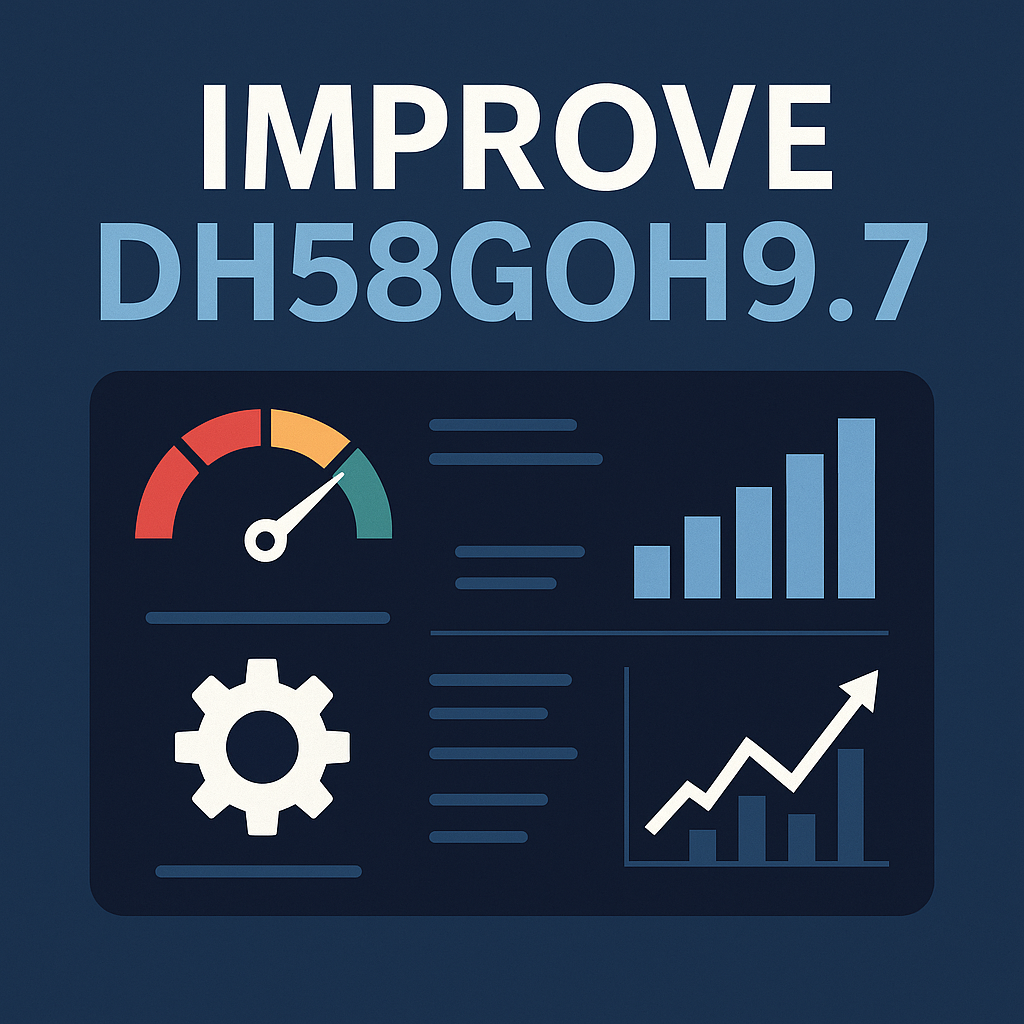How to Effectively Improve DH58GOH9.7: Complete Optimization Guide
In the modern age of digital transformation, system identifiers like DH58GOH9.7 are often associated with proprietary configurations, custom software builds, or internal version codes. Whether DH58GOH9.7 is a version tag in a software development cycle, a firmware revision, a machine learning model, or an internal product configuration, one thing is clear—there is a consistent need to improve and enhance it for better results.
The demand to improve DH58GOH9.7 might stem from performance concerns, security gaps, user feedback, system crashes, or integration issues. Regardless of the context, improvement is key to staying ahead in competitive digital landscapes. This article offers a comprehensive overview and action plan to successfully improve DH58GOH9.7 across multiple domains.
Understanding What DH58GOH9.7 Represents
Before initiating any improvements, it’s essential to understand what DH58GOH9.7 stands for. In most cases, such a unique string refers to:
-
A software or system version
-
A component model or firmware update
-
An internal code for a specific environment or deployment
-
A product version label for testing and deployment
If you are working within a company or development environment that uses DH58GOH9.7 as a version reference, your role may involve enhancing its performance, fixing bugs, optimizing user interface design, or strengthening backend security. Clarity on what DH58GOH9.7 is and how it functions is critical before you begin the improvement process.
Reasons to Improve DH58GOH9.7
There are several reasons why stakeholders would want to improve DH58GOH9.7. Improvement isn’t just about fixing something that’s broken; it’s about building something better. Below are some common reasons:
-
Poor system response times or application latency
-
Bugs and error messages in end-user experience
-
Compatibility issues with newer environments or platforms
-
Outdated technology stack or deprecated components
-
Weak security protocols vulnerable to attacks
-
Lack of modern features or scalability
Each of these issues demands an upgrade or optimization plan aimed at significantly improving DH58GOH9.7.
Evaluate the Current Performance of DH58GOH9.7
The first step in improvement is to conduct a thorough evaluation of how DH58GOH9.7 currently performs. This involves:
-
Monitoring CPU and memory usage if DH58GOH9.7 is hardware-related
-
Reviewing logs, error reports, or crash diagnostics
-
Assessing feedback from users or QA teams
-
Analyzing system benchmarks, boot time, and overall responsiveness
-
Checking how the system behaves under load conditions
You can’t improve what you don’t measure. Collecting data is essential to identify the exact weaknesses and plan your improvement strategy accordingly.
Technical Improvements to DH58GOH9.7
Once you’ve diagnosed the issues, you can begin implementing technical improvements.
Upgrade Dependencies and Libraries
If DH58GOH9.7 involves code, outdated libraries or packages could be causing inefficiencies or security risks. Updating these packages ensures compatibility and improves performance.
Refactor Inefficient Code
Poorly written code can significantly drag down system performance. Analyze code for inefficiencies such as:
-
Unoptimized loops and conditions
-
Excessive memory allocation
-
Repetitive tasks that can be modularized
-
Lack of error handling
Refactoring improves readability, maintainability, and performance.
Optimize Database Queries
If DH58GOH9.7 interacts with a database, slow or unindexed queries can hinder performance. Improve by:
-
Using indexes appropriately
-
Avoiding SELECT *
-
Normalizing tables where necessary
-
Reducing joins or nested subqueries
These small changes can lead to major improvements in database speed and resource consumption.
Enhance Security to Improve DH58GOH9.7
Security is a major part of any improvement process. Enhancing DH58GOH9.7’s security features can prevent future threats and maintain data integrity.
-
Implement encryption for data in transit and at rest
-
Use token-based authentication and secure APIs
-
Regularly audit code for vulnerabilities
-
Apply firewall rules and access controls
-
Keep all components patched and updated
These practices not only protect users but also boost the system’s reliability.
Improve User Interface and Experience
If DH58GOH9.7 includes a user-facing interface, make it smoother and more modern:
-
Simplify navigation menus and reduce clutter
-
Use responsive design techniques for mobile compatibility
-
Optimize loading time with lightweight assets
-
Enhance accessibility for users with disabilities
Improving UX/UI often translates into increased adoption and user satisfaction.
Automate Testing and Deployment
One of the most efficient ways to improve DH58GOH9.7 is by automating repetitive tasks. Use continuous integration and deployment (CI/CD) pipelines:
-
Automate unit testing, integration testing, and regression testing
-
Automate deployments to staging and production environments
-
Monitor automatically for build failures and test coverage
This minimizes human error, speeds up releases, and ensures quality control.
Stress Test and Load Test DH58GOH9.7
Testing under load is crucial. Many systems perform well under normal conditions but fail when user demand spikes. Use stress testing tools to simulate high traffic and assess how DH58GOH9.7 handles it. Adjust load balancers, optimize resource allocation, or scale components horizontally if necessary.
Collect Feedback and Iterate
Improvement is a continuous process. After implementing changes, collect new feedback from users, stakeholders, and testers.
-
Use bug tracking systems like Jira or GitHub Issues
-
Monitor logs and analytics for unexpected behaviors
-
Review performance improvements against benchmarks
-
Get real-time insights through application monitoring tools
Based on this feedback, continue iterating to refine DH58GOH9.7 even further.
Documentation and Knowledge Sharing
Don’t neglect documentation. A well-documented DH58GOH9.7 system ensures that future developers and users understand the changes made. Document:
-
Version history
-
Upgrade instructions
-
Known limitations
-
System architecture and component diagrams
Also, consider creating internal tutorials or guides to help teams adopt the improved system more easily.
Common Pitfalls When Trying to Improve DH58GOH9.7
There are a few mistakes to avoid during the improvement process:
-
Rushing without testing thoroughly
-
Ignoring end-user input
-
Not maintaining compatibility with older versions
-
Failing to back up the original version before changes
-
Skipping documentation
Avoiding these errors will save you time and reduce risks during deployment.
Future-Proofing DH58GOH9.7
Once improvements are made, think long-term. You can future-proof DH58GOH9.7 by:
-
Implementing modular architecture for easier upgrades
-
Adopting scalable cloud infrastructure
-
Monitoring continuously for performance and threats
-
Scheduling regular audits and reviews
By doing this, your system will remain relevant, reliable, and resilient over time.
Read also: Complete Guide to the Features and Benefits of Microwave MCWV4512Z
Conclusion
Improving DH58GOH9.7 requires a structured, comprehensive approach that spans technical upgrades, user experience refinement, security enhancements, and continuous feedback. Whether you’re dealing with a backend system, a software build, or an internal module, the techniques discussed above are applicable across domains.
By taking a measured and data-driven approach, you can transform DH58GOH9.7 into a high-performing, secure, and future-ready version of its former self. The goal isn’t just to fix what’s broken—it’s to build something better, faster, and more effective. When you commit to continuous improvement, the value of DH58GOH9.7 increases dramatically, benefiting both developers and users alike














Post Comment